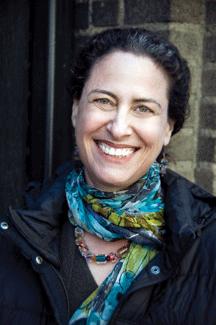
According to Rabbi Nancy Flam, prayer is like a symphony — you would appreciate it more if you understood the music better. Of course this is a metaphor, but her message is that if we better understood the structure of liturgical prayer and how it is meant to move us, we would access the spiritual component that is missing by just going to shul and letting “whatever happens happen.”
Rabbi Flam will address various ways of praying when she visits here April 21-23 as scholar in residence at The Temple, Congregation B’nai Jehudah. (See box for details.) She says she was invited in order to engage people in some experiments in prayer practices, thus widening the perception of what prayer might be.
Rabbi Flam says many Jews, whether Reform, Conservative, Orthodox, Renewal or Reconstructionist, think about prayer as what happens in synagogues with a prayer book. But one’s prayer life can also happen outside of the sanctuary, without a prayer book.
“There are a number of authentic Jewish prayer practices, from chanting a single line of inspirational content from sacred literature to ‘hitbodedut,’ which is the cultivation of a spontaneous conversation with the divine, however you understand that, and what happens when one sets aside time to cultivate that relationship,” she says.
As co-founder with Rabbi Rachel Cowan of the Institute for Jewish Spirituality, Rabbi Flam says it was clear to them that many Jews were having a hard time accessing a spiritual component of life. Attending services and programs were not enough.
“There was something in a life that wasn’t being addressed, attained and nurtured in a really ongoing, systematic way,” she says. “There was a certain dryness and emptiness that many American Jews were feeling and so they were going to other traditions — Buddhist retreats, Hindu ashrams, seeking through yoga. So we founded the institute in order to address that need.”
How might it be if someone took on prayer outside the synagogue, Rabbi Flam asks, praying on a regular basis? It would not only be satisfying for the individual, but condition him or her when going to a communal place of prayer to feel there’s more prayer happening internally, and that affects the community.
“Our communal prayer is really only as good as our individual prayer is,” the rabbi says.
Just “attending” services tends to be very passive. Rabbi Flam says prayer needs to be a practice in order for it to flourish and affect our lives in a positive way. We need to be taught how to actively engage in prayer.
“It’s not just thinking about prayer, it’s choosing some form or forms of practice to incorporate into our life that is active, it’s specific, it has consequences in terms of how we see and think and feel and move through everyday life,” Rabbi Flam explains. “But mostly we’re asleep and prayer comes to wake us up to what’s really happening, which is that there is a source that enlivens us and the world at every moment.”
Many people pray as an obligation, a mitzvah or a commandment, says Rabbi Flam. Others experience prayer as just something that occasionally occurs or doesn’t. But to explore prayer as a spiritual practice means taking on a particular way of prayer, whether it’s liturgical, hitbodedut, contemplative or chanting — some particular practice that is going to cultivate our very being, our consciousness or awareness and our character.
“So what’s going to happen through that practice over time — if it’s a practice that’s befitting of who you are, your personality, your stage of life — is it’s actually going to have an effect in your life,” she says. “You may become a more aware person, a more sensitive person, a person who responds to the world more generously.”
Rabbi Flam says rather than just show up at services asking yourself if you like the cantor or the rabbi, the music, if the service is long enough or short enough, ask yourself how to orient your own heart and mind toward what’s going to happen there. Do you know how to orient yourself, where you are aiming?
“The whole first part of the service is about inviting our bodies to show up, how we actually get our bodies on line,” she continues. “Sometimes you show up for prayer and you’ve left your body somewhere else. Prayer is like a contact sport; it’s a fully-embodied experience. You can’t play well if you aren’t inhabiting your body.
“The whole second part is about inviting the heart to open with song and verses of psalm. The whole third part is about making our clear affirmations and declarations and commitments. It’s more of a mind activity. And there’s the next part of the service that’s really just meant to be very quiet and individual.”
Rabbi Flam says it doesn’t matter how you think about God; you want to think more about how you are accessing your deepest yearnings and commitments within yourself in terms of communication.
“Rabbi David Ingber says it’s more important where prayer comes from than where it’s going to. I like that as a thought,” she says. “There are lots of ways of thinking about prayer. But unfortunately people get really stuck. ‘Who’s listening?’ ‘I don’t believe in that kind of God.’ So let’s work on that; let’s play around with that and do some real work to see how we can access a connection to something greater than we are, which is a source of goodness.”
Rabbi Flam was ordained as a Reform rabbi but says she now calls herself post-denominational. She has spent time at Conservative seminaries and is very much influenced by early Hasidic teachings.
She lives in Northampton, Massachusetts, with her husband Neil Kudler and is mother to young adults Miriam and Jonah.



